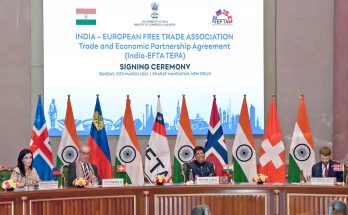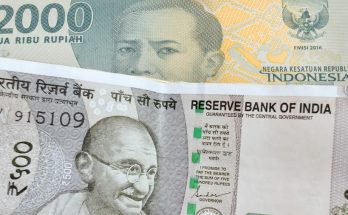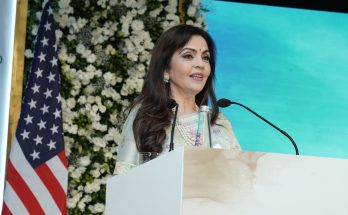 India’s foreign trade has badly suffered since the beginning of the global financial crisis in August-September 2008. The subsequent shock of the sovereign crisis in Eurozone added to the problem. The growth trends in exports and imports became erratic with the changing situation. After a negative trend in export growth (-1.82%) in 2012-13, the performance improved to 4.66% in 2013-14. But imports dipped to -8.26% in 2013-14 from a low base of 0.29% in the previous year. Trade balance remained negative at $1,35,794 million.
India’s foreign trade has badly suffered since the beginning of the global financial crisis in August-September 2008. The subsequent shock of the sovereign crisis in Eurozone added to the problem. The growth trends in exports and imports became erratic with the changing situation. After a negative trend in export growth (-1.82%) in 2012-13, the performance improved to 4.66% in 2013-14. But imports dipped to -8.26% in 2013-14 from a low base of 0.29% in the previous year. Trade balance remained negative at $1,35,794 million.
The growth in exports improved in the current fiscal (April-August 2014), growing at 7.31%. to $1,34,798 million. But the growth in imports turned negative by 2.69%, with $4,50,200 million trade balance improved but still remained negative at $56,151 million. As the manufacturing sector in the country is picking up imports of capital goods, machinery and key raw materials are likely to rise. However services enjoy positive trade balance.
Over dependence on markets in the developed countries was the cause for shrinkage in exports. As the recovery in developed countries leading to increase in demand is slow, India should strengthen trade bonds with the developing and least developed countries. Instead of pushing for Bilateral Investment and Trade Agreement (BITA) with the EU which is fraught with problems like intellectual property rights, agreements on dairy and pharma sectors, India should look for more South-South cooperation and extend its outreach to new non-traditional markets in Latin America and the Caribbean, central Asian republics, Africa, small Pacific island countries and even explore greater opportunities in Russia for exports. The energy-rich countries and those endowed with natural resources in these regions can attract Indian investments and solve the problem of India’s energy security. India should focus on project exports to Africa, West Asia, central Asian republics and some ASEAN countries.
The recovery in developing countries is faster than in the developed world. Bonds with these countries will help India to fight against developed world for a level playing field at the WTO.
Trade has invariably become an integral part of diplomacy. As the new Indian government is slated to come out with a new Foreign Trade Policy for the next five years, it would be advisable that the Ministry of Commerce and Industry work in close cooperation with the Ministry of External Affairs. Adequate incentives should be given for export promotion to Latin America and the Caribbean, Africa, Pacific Islands, Central Asian republics and Russia.
India had made some initial attempts to explore new export destinations in South America and the Caribbean, but with limited success.
India’s Ministry of External Affairs has just begun the process of engaging with the Community of Latin American and Caribbean States (CELAC), consisting of 33 sovereign countries representing about 600 million people. The group includes Mexico and excludes Canada and the United States, as well as the territories of France, the Netherlands, Denmark and the United Kingdom in the Americas. There are sub-regional groupings like Mercosur and the Andean India should engage.
CELAC was created on December 3, 2011, in Caracas, Venezuela to deepen Latin American integration and to reduce the once overwhelming influence of the US on the politics and economics of Latin America. It is an alternative to the Organisation of American States (OAS), the regional body organised largely by Washington in 1948, ostensibly as a countermeasure to the then potential Soviet influence in the region. This is the right time for India step in, particularly when it has closer relationship with a major country in the region, Brazil.
However in the last year, there was over 20% decline in India’s exports to Latin America, but in the first quarter of the current fiscal Indian exports to Latin America has grown by 35% from $2.1 billion to $2.9 billion. Exports to Brazil grew by 75%, followed by exports to Peru by 25% and exports to Columbia by 17%. However, the import restrictions imposed by Argentina is a cause of concern.
CELAC is diverse with countries following different economic systems and trade policies. It has 18 Spanish-speaking countries, one each Portuguese, French and Dutch-speaking country and 12 English-speaking countries. However, by and large the countries in the region want to move out of the preponderant US influence. China is also engaging with the region. Trade between China and Latin America grew by 8% to $255.5 billion in 2012, faster than the 6.2% growth of the continent’s trade with the US. A study by the United Nations Economic Commission for Latin America and the Caribbean predicts China will surpass the European Union as Latin America’s second-largest trading partner in 2016. Some estimates forecast that in 15 years, China will overtake the US to become Latin America’s largest trade partner. Chinese investment in the continent’s energy and infrastructure sectors is rising rapidly, with more than $550 billion of infrastructure projects in the market. It is to be seen how effectively India plays its diplomacy in the region for boosting trade relations and energy imports.
India mainly engages with the diverse African continent through the 54-nation African Union. But Morocco is not a member of the AU, while some countries remain suspended from membership due to political reasons. It would be better for India to engage with the regional groups in Africa, if not directly with countries. Regional groups have overlapping membership. There are eight groups recognised by the African Union like Arab Maghreb Union (AMU), Common Market for Eastern and Southern Africa (COMESA), Community of Sahel-Saharan States (CEN-SAD), East African Community
(EAC), Economic Community of Central African States (ECCAS), Economic Community of West African States (ECOWAS), Inter-governmental Authority on Development (IGAD) and Southern African Development Community (SADC).
There are eight other groups not recognised by the African Union like Economic and Monetary Community of Central Africa (CEMAC), West African Economic and Monetary Union (UEMOA/WAEMU), Economic Community of the Great Lakes Countries (CEPGL), Indian Ocean Commission (IOC), Mano River Union (MRU), Southern African Customs Union (SACU), International Conference on Great Lakes Region (ICGLR/CIRGL), Senegal River Basin Development Authority (OMVS). Thus it would be tactical for India to engage with each of these groups.
Traditionally, India has good trade relations with eastern, northern and southern Africa. It is time to give added focus for developing greater trade relations with central and western Africa. The prospects for engaging with sub-Saharan Africa looks bright with good recovery in the region.
In its Look East Policy, India has already engaged itself substantially with the Southeast Asia and East Asia. It is now time to look further east and engage with the resource-rich small Pacific Ocean islands. With Australia and New Zealand in the region partnering with these countries, it would not be difficult to engage with these countries that form the Pacific Ocean Island Forum at which India enjoys an observer status.
Though the growth rate in central Asian republics and Russia remain subdued, it opportune moment for India to engage with the energy-rich region endowed with natural resources. The situation of recent EU and US sanctions against Russia provides an opportunity for India to regain its lost markets in specific products.
(Ashok B Sharma is a senior journalist and have long since been writing on WTO and international trade).
Author Profile
- India Writes Network (www.indiawrites.org) is an emerging think tank and a media-publishing company focused on international affairs & the India Story. Centre for Global India Insights is the research arm of India Writes Network. To subscribe to India and the World, write to editor@indiawrites.org. A venture of TGII Media Private Limited, a leading media, publishing and consultancy company, IWN has carved a niche for balanced and exhaustive reporting and analysis of international affairs. Eminent personalities, politicians, diplomats, authors, strategy gurus and news-makers have contributed to India Writes Network, as also “India and the World,” a magazine focused on global affairs.
Latest entries
 DiplomacyApril 10, 2024Diplomat-author Lakshmi Puri pitches for women power at LSR
DiplomacyApril 10, 2024Diplomat-author Lakshmi Puri pitches for women power at LSR India and the WorldApril 6, 2024UN envoy pitches to take India’s solutions to the world stage
India and the WorldApril 6, 2024UN envoy pitches to take India’s solutions to the world stage CultureApril 5, 2024Youth in Diplomacy: Making it Matter with LSR Model UN 2024
CultureApril 5, 2024Youth in Diplomacy: Making it Matter with LSR Model UN 2024 India and the WorldMarch 28, 2024India to China: Normalization of troops deployment imperative for restoring ties
India and the WorldMarch 28, 2024India to China: Normalization of troops deployment imperative for restoring ties







